Translate this page into:
Delayed diagnosis of metastatic squamous cell carcinoma presenting as mild subungual bleeding
Corresponding author: Dr. Yonghu Sun, Department of Dermatology, Hospital for Skin Diseases, Shandong First Medical University, Shandong, Jinan, China. suohandong@126.com
-
Received: ,
Accepted: ,
How to cite this article: Tu XJ, Lyu C, Zhang F, Liu Y, Sun Y. Delayed diagnosis of metastatic squamous cell carcinoma presenting as mild subungual bleeding. Indian J Dermatol Venereol Leprol. doi: 10.25259/IJDVL_967_2023
Dear Editor,
Subungual squamous cell carcinoma (Subungual SCC) is a rare neoplasm of the skin. Diagnosis of subungual SCC is often challenging given the resemblance to other common nail diseases, such as paronychia, onychomycosis, and papilloma. Herein, we report the case of a 62-year-old woman with a 3-year history of indolent subungual bleeding from the right ring finger. Similar symptoms had also been present 10 years ago affecting the same nail. A lymph node biopsy of the right axillary and supraclavicular lymph nodes confirmed a diagnosis of squamous cell carcinoma (SCC) of epithelial origin. She received chemotherapy which led to a temporary improvement in the subungual lesion followed by a recurrence for which the patient was referred to us 3 years ago. At the presentation, there was an irregular scaly plaque affecting the hyponychium of the right ring finger with occasional bleeding, accompanied by a localised thick yellow nail plate [Figure 1a]. Dermoscopy in the polarised mode revealed a pink, translucent structureless area, a nail plate with free edge thickening, a fuzzy lesion edge, and subungual bleeding accompanied by white scales and yellow keratinous crusts [Figure 1b]. A nail bed biopsy showed dyskeratotic cells, atypical keratinocytes, and an irregularly thickened epithelium [Figure 1c]. Positron emission tomography- computed tomography (PET-CT) showed no visceral malignancy and a positive uptake in the right ring finger [Figures 2a–2d]. The lesion was excised by distal digit amputation. The pathologic evaluation was diagnostic of SCC with axillary metastases [Figure 3].
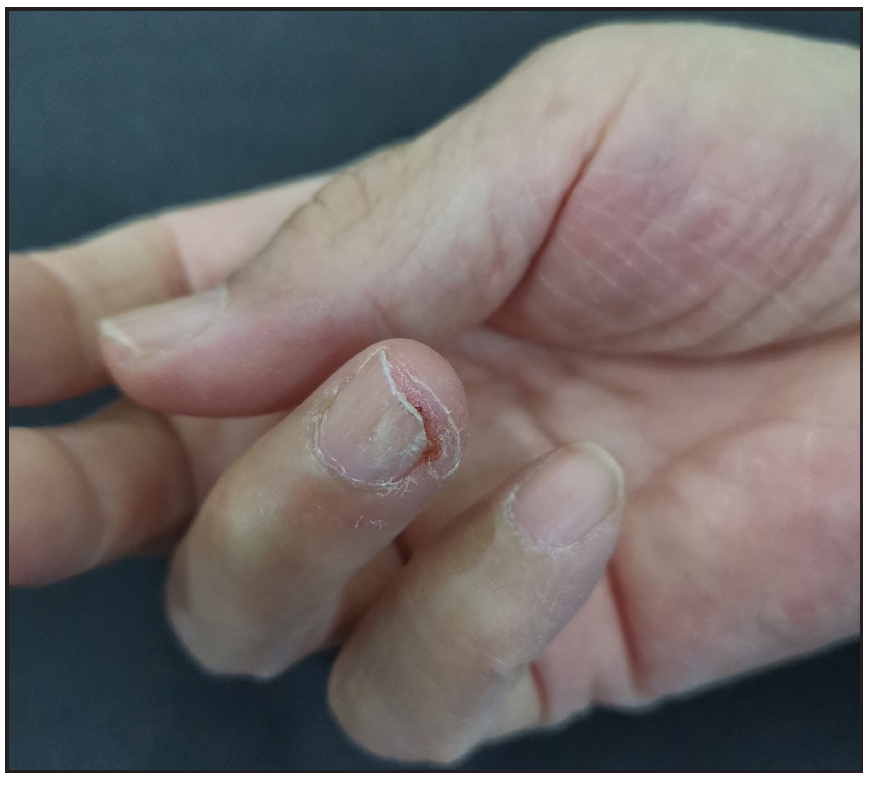
- Distal onycholysis of the ring fingernail of the right hand.
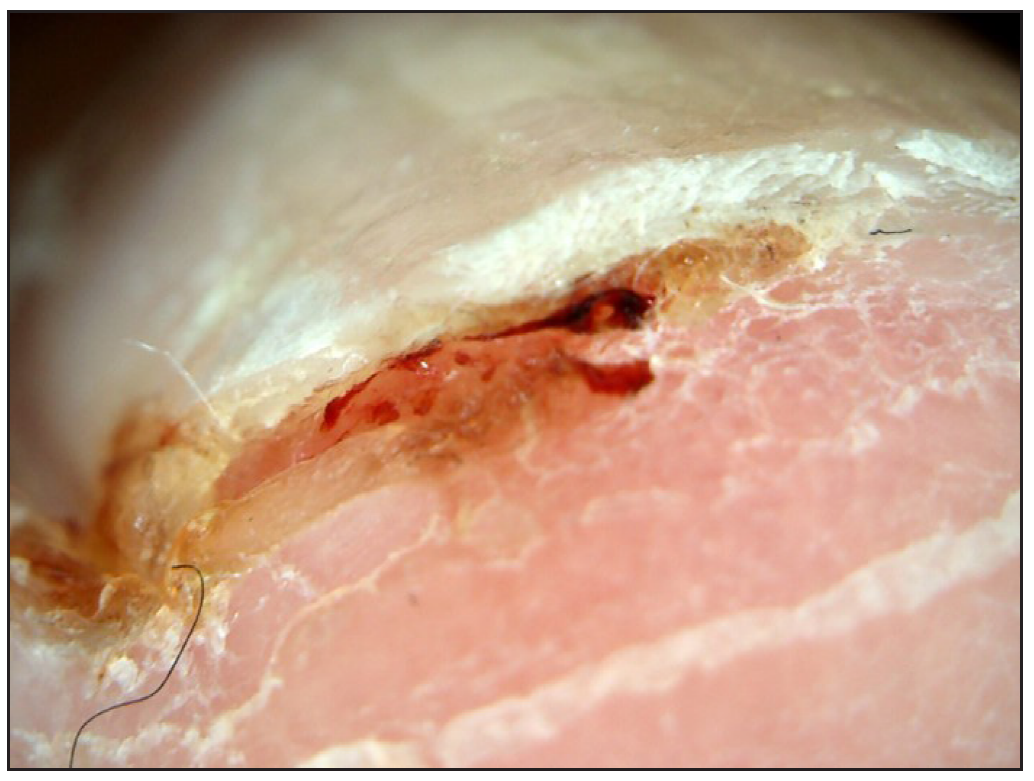
- Dermoscopy revealed a pink background, a translucent area without structures, localised nail plate free edge thickening, a fuzzy lesion edge, and subungual bleeding, accompanied by white scales and yellow keratinous crusts (polarised magnification x50, Guangzhou Chuanghong Medical Technology).
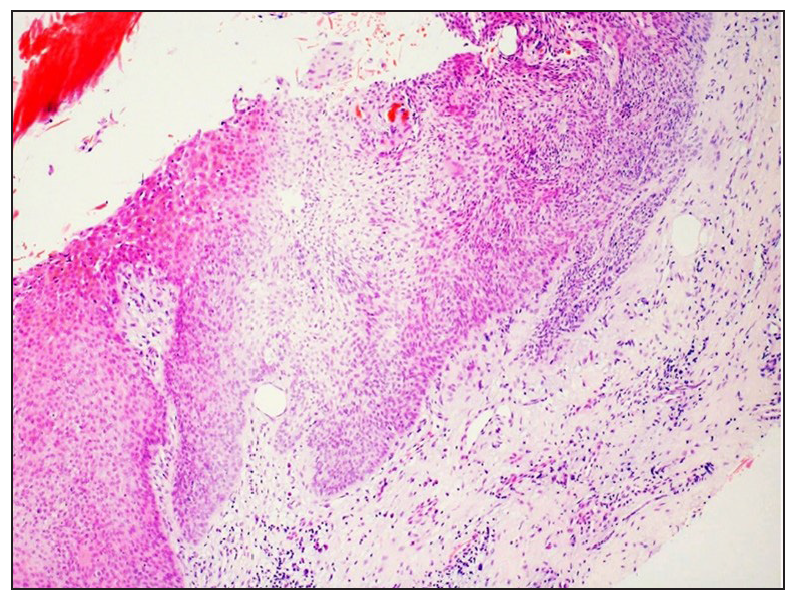
- Nail apparatus pathology showed irregularly thickened epithelium and obvious atypia (Haematoxylin and Eosin; 200x).
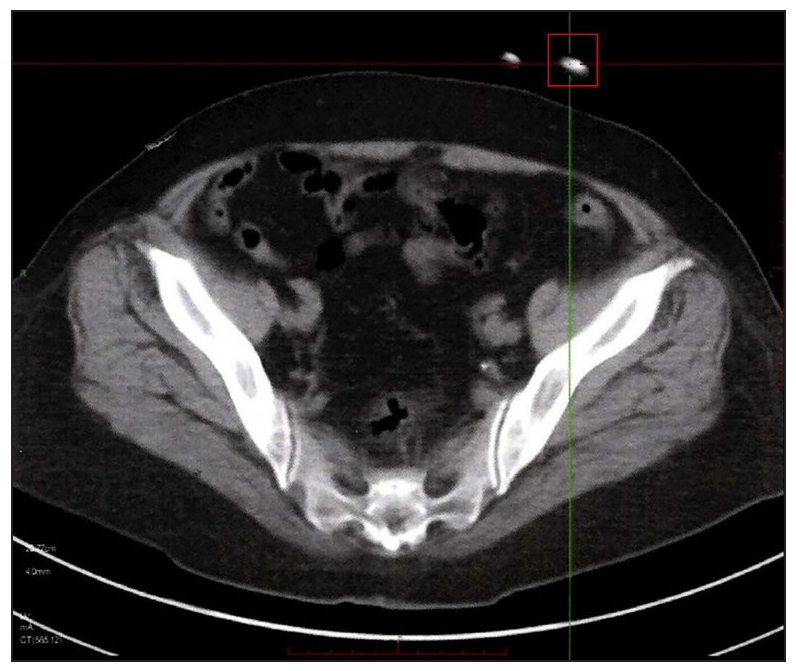
- Transverse axial Computed Tomography (CT) images before distal amputation highlight the position of the lesion.
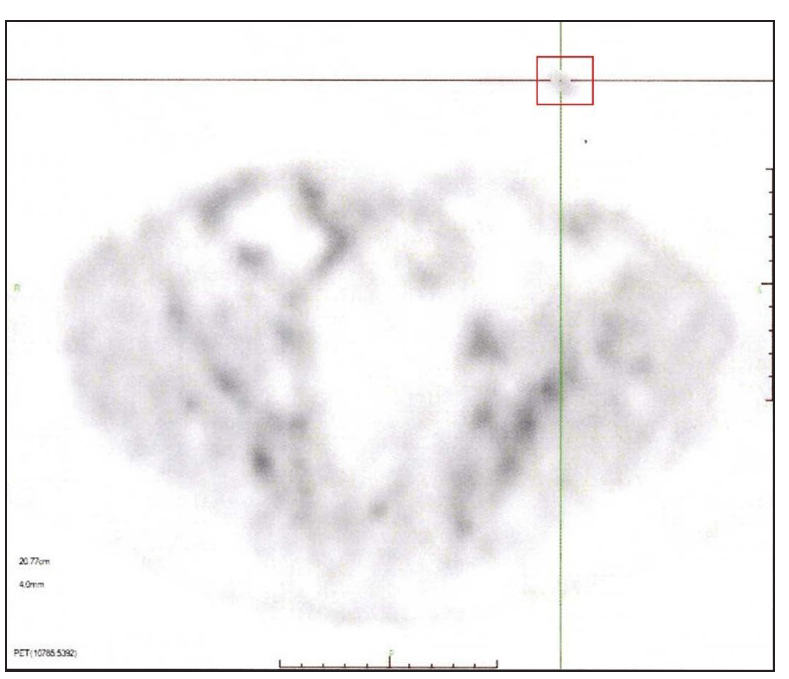
- Transverse axial scanning demonstrates hypermetabolic lesions with PET image (Red square showed the position of right ring fingernail).
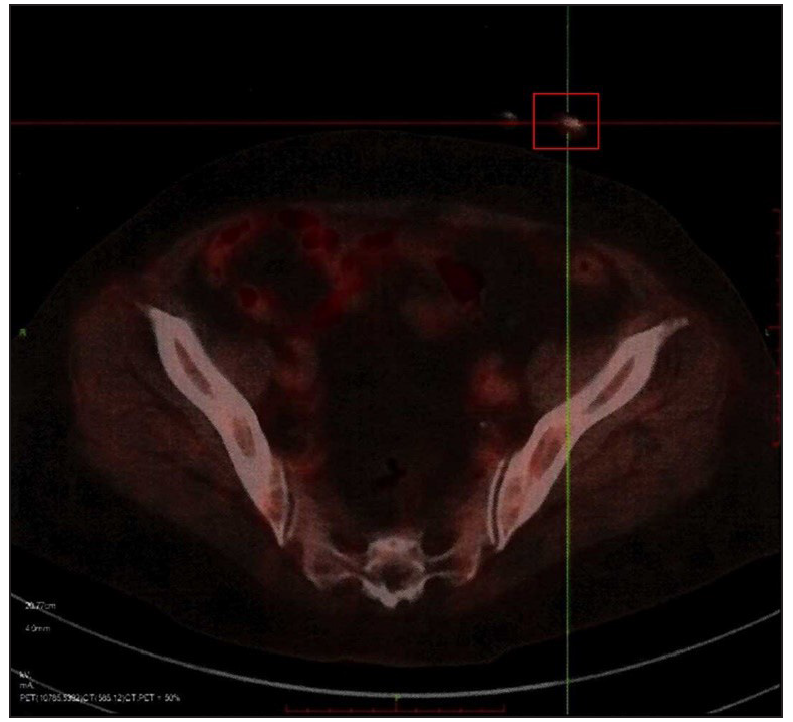
- Fusion image of CT and PET scanning showed hypermetabolic lesions of the right ring fingernail.

- PET image in the coronal plane scanning shows the lesion in the right ring fingernail. (Highlighted in the red square).
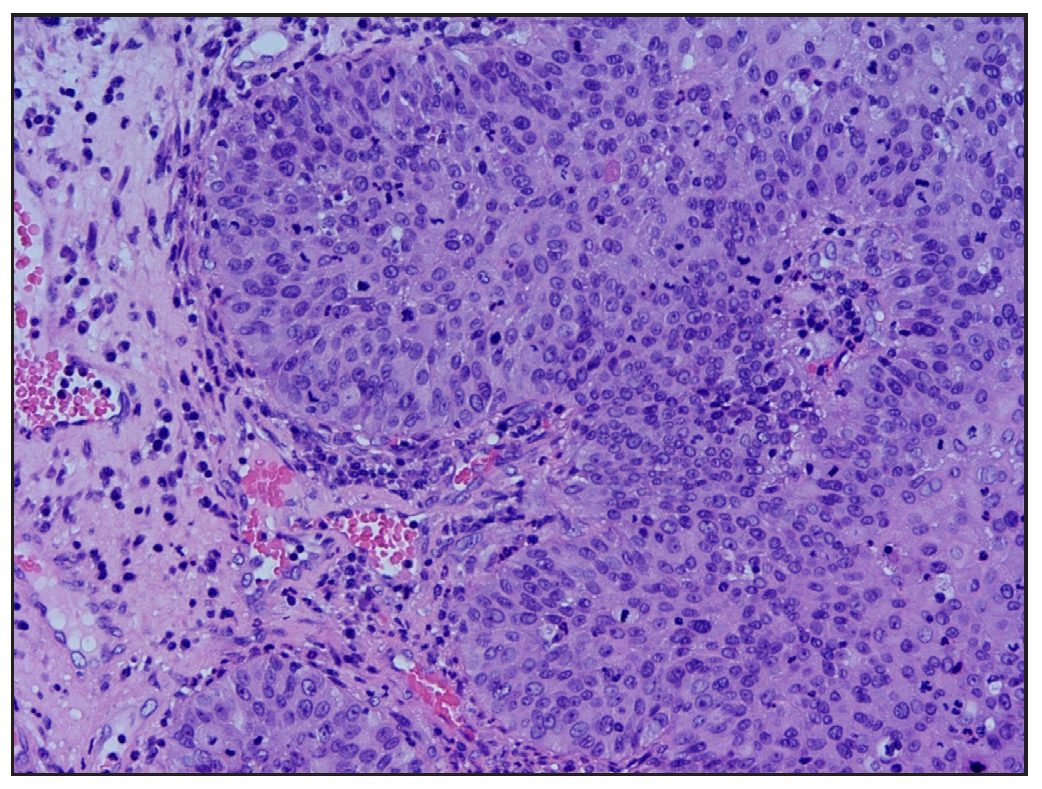
- Postoperative pathology displayed disordered architecture with nests of heterotypic cells (Haematoxylin and Eosin; 200).
Subungual bleeding could be caused by trauma, dermatoses, tumour, vasculitis, drug reactions, or infectious diseases.1 Traumatic subungual bleeding usually presents as black discoloration located distally in most patients; however, lesions are more red and more proximal in patients with systemic diseases.1 Subungual SCC should be suspected in patients with long-term recurrent nail disease that does not respond to treatment. In this case, the patient presented with long-term recurrent indolent subungual bleeding, and there was no history of trauma. Dermoscopy and biopsy are indicated at the earliest possible once this suspicion arises. There are no diagnostic criteria for dermoscopic characterisation of subungual SCC. Common dermoscopic features include a pink background, translucent structureless areas, white scales, and dotted or irregular vessels.2 Our patient showed most of these features except vascular structures. Subungual SCC’s are generally considered low-grade malignancies with a low propensity to metastasize. However, there are usually delays in the diagnosis, which results in delayed treatment.3 Huang et al.4 reported a patient who presented with metastatic SCC in the left groin 3 years following his first diagnosis of a subungual SCC presenting on his left fifth toe. Dalle et al.5 reported a median delay in diagnosis of subungual SCC to be 24.5 months. One of the 35 patients in this series died from lung metastases.
Though there are currently no established treatment guidelines for subungual SCC, it is generally accepted that most can be successfully treated with surgical excision.3 When there is no involvement of the distal phalangeal bone, Mohs surgery and wide surgical excision can be performed whereas amputation of the distal phalanx or disarticulation of the involved digit is often indicated for invasive disease.3 Metastatic tumours, in addition, require block dissection of the regional lymph nodes, postoperative irradiation of the draining lymph nodes, and systemic chemotherapy.6 Kelly et al.7 suggested that early management of metastatic disease with complete lymphadenectomy or radiation is strongly recommended. This was the treatment plan followed in our patient too.
This case illustrates the significance of a thorough history and physical examination to allow early and accurate diagnosis of subungual SCC for a better prognostic outcome. Furthermore, although it metastasises rarely, physicians must be aware of this possibility.
Declaration of patient consent
The authors certify that they have obtained all appropriate patient consent and we thank the patient for granting permission to publish the information.
Financial support and sponsorship
This work was supported by the Taishan Scholars Program of Shandong Province (tsqn201909141) and the Shandong Provincial Youth Science and Technology Talents Support Plan (ZR2020YQ56).
Conflicts of interest
There are no conflicts of interest.
Use of artificial intelligence (AI)-assisted technology for manuscript preparation
The authors confirm that there was no use of artificial intelligence (AI)-assisted technology for assisting in the writing or editing of the manuscript and no images were manipulated using AI.
References
- Splinter hemorrhages of the nails: A systematic review of clinical features and associated conditions. Int J Dermatol. 2016;55:1304-10.
- [CrossRef] [PubMed] [Google Scholar]
- Intraoperative dermoscopy features of subungual squamous cell carcinoma: A study of 53 cases. Clin Exp Dermatol. 2021;46:82-8.
- [CrossRef] [PubMed] [Google Scholar]
- Squamous cell carcinoma of the nail unit: Review of the literature. J Hand Surg Am. 2018;43:374.e2-379.e2.
- [CrossRef] [PubMed] [Google Scholar]
- Late inguinal metastasis of a well-differentiated subungual squamous cell carcinoma after radical toe amputation. Dermatol Surg. 2005;31:784-6.
- [CrossRef] [PubMed] [Google Scholar]
- Squamous cell carcinoma of the nail apparatus: Clinicopathological study of 35 cases. Br J Dermatol. 2007;156:871-4.
- [CrossRef] [PubMed] [Google Scholar]
- Subungual squamous cell carcinoma of the toe: Working toward a standardized therapeutic approach. J Surg Educ. 2008;65:297-301.
- [CrossRef] [PubMed] [Google Scholar]





